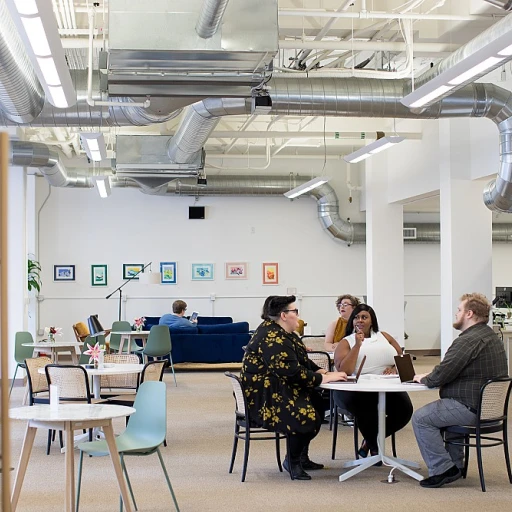
The Rise of Remote Work Tools
Transformative Digital Tools are the New Norm
The surge in remote work tools has fundamentally transformed the modern workplace. With digital workplaces becoming increasingly common, businesses are navigating an evolving landscape where technology plays a central role. In recent years, advancements in workplace technologies have led to an increase in the availability and sophistication of digital tools designed to support remote work. Tools such as communication software and project management systems serve as pivotal components in ensuring collaboration and effective communication in real time. These digital solutions cater to both personal and professional needs, allowing workers to stay connected and informed, regardless of physical location. This shift towards a hybrid work model has prompted companies to rethink traditional office setups, emphasizing the need for robust, reliable technology. In a digital workplace, effective communication is key. The introduction of enhanced technology solutions has made it easier for employees and teams to collaborate effectively, even from a distance. Remote work tools provide employees with the flexibility needed to maintain productivity while enhancing the overall employee experience. Employers are investing heavily in innovative workplace technologies to support hybrid work environments, paving the way for greater flexibility and productivity. As businesses continue to adapt, the importance of effectively integrating these digital tools becomes even more apparent. For a deeper understanding of how these tools shape the future of work, check out this insightful article on harnessing AI for conceptual adaptation in the workplace.AI and Automation: Redefining Job Roles
The Impact of AI and Automation on Job Roles
The convergence of artificial intelligence and automation is reshaping how tasks are performed across the workplace. These digital technologies are transforming job roles and altering the dynamics of the office environment. While some workers may fear these technologies will replace their roles, the reality is more nuanced. AI and automation are set to redefine task completion, augmenting the capabilities of employees and enhancing personal and professional productivity. The integration of AI in the workplace offers significant advantages by automating routine and repetitive tasks, allowing employees to focus on more complex and strategic projects. This shift facilitates better decision-making processes and enhances the overall employee experience. Business leaders need to ensure that digital solutions are effectively implemented, integrating AI into their project management and decision-making systems to optimize business outcomes. Furthermore, as these technologies become more prevalent, businesses are provided with innovative tools and solutions that help address new challenges within the digital workplace. From improved data analysis capabilities to tailored communication systems, AI fosters a more efficient use of time, empowering teams to achieve greater productivity and collaboration without the constraints of traditional manual processes. However, the shift towards automation and AI also compels companies to rethink their workforce strategies. Organizations need to invest in upskilling and reskilling their workforce to match the evolving demands of hybrid and technology-rich work environments. By doing so, companies can alleviate employee fears about job displacement and ensure a smooth transition to an automated workplace. For those interested in learning how to navigate these changes effectively, creating an AI-ready administrative assistant resume is a valuable resource. This approach not only prepares individuals for the evolving job market but also enhances their adaptability in this new era of workplace tech.Cybersecurity in the Digital Workplace
Securing the Digital Landscape: Prioritizing Cyber Defense
In the constantly evolving realm of workplace technology, ensuring data security has become a pressing concern for companies worldwide. As more businesses incorporate digital solutions into their operations, safeguarding sensitive information from cyber threats is paramount. The increased reliance on remote work has amplified the need for robust cybersecurity measures to protect the digital workplace from vulnerabilities. Companies are progressively investing in advanced cybersecurity systems to monitor and detect unusual activities in real time. Tools such as firewall software and encryption solutions are being employed to secure communication channels and protect data privacy. By implementing these technologies, businesses can mitigate the risks associated with digital threats and enhance their overall security posture. Employee training is also crucial in fortifying cybersecurity defenses. Organizations are realizing that an informed workforce can act as a front line of defense against potential breaches. This includes educating employees on recognizing phishing attempts, understanding the importance of strong passwords, and adhering to secure work practices. Such proactive measures help develop a more security-conscious work environment, ultimately reducing the likelihood of data breaches. With hybrid work arrangements becoming the norm, businesses are tasked with developing strategies that cater to both on-site and remote workers. This shift demands a balanced approach, integrating technology solutions that accommodate various work settings while prioritizing cybersecurity. Ultimately, the secure integration of workplace technologies plays a pivotal role in optimizing the employee experience and maintaining operational continuity. For a deeper understanding of how businesses can adapt to technological changes, further insights into the topic can be explored in the article on conceptual adaptation in the workplace.Collaboration Platforms: Enhancing Teamwork
Revolutionizing Team Dynamics through Digital Solutions
In an era where workplace technology is becoming a defining factor for businesses, digital tools play a crucial role in enhancing teamwork. These platforms are reshaping how employees connect and collaborate, enabling seamless communication across different locations and time zones. The shift towards hybrid work has further amplified the need for systems that support both remote work and in-office interactions, fostering a dynamic and adaptable digital workplace. Digital technologies offer a myriad of solutions that promote effective collaboration. Companies are increasingly adopting project management tools that allow workers to track tasks, share files, and communicate in real time. These digital tools not only streamline workflows but also improve the overall employee experience, leading to higher productivity and job satisfaction. For businesses, investing in workplace technologies that facilitate efficient communication and collaboration is essential. By integrating such solutions, companies can create a more cohesive work environment where employees can thrive both personally and professionally. Whether through cloud-based software or AI-driven communication collaboration systems, the future of work is undoubtedly digital. Embracing these technologies also supports decision making, as data-driven insights from collaboration platforms can inform strategic business moves. As companies continue to evolve, the role of technology in enhancing teamwork will become even more pivotal, aligning workplace goals with digital innovation.The Role of Virtual and Augmented Reality
Embracing Virtual Reality for a Dynamic Work Environment
In today's rapidly evolving work environment, virtual reality (VR) and augmented reality (AR) have emerged as transformative workplace technologies driving productivity and immersive experiences. These digital tools are not only reshaping how employees interact within digital workspaces but also how they collaborate and solve problems. VR and AR present companies with an opportunity to break traditional boundaries by offering remote work solutions that are interactive and engaging. For instance, industries that traditionally relied on physical presence, such as manufacturing and healthcare, are now utilizing VR for training and simulation. This results in enhanced employee experience and improved decision making by allowing workers to practice tasks in a risk-free, virtual setup. This shift towards immersive technologies has a positive ripple effect on hybrid work models. Employees can navigate between physical office settings and digital spaces seamlessly, enhancing communication collaboration and increasing real-time interaction. Businesses can now hold meetings that feel more personal and professional, even if participants are miles apart. Furthermore, the adoption of VR and AR tools is instrumental in project management and communication systems. Teams can virtually gather to conceptualize ideas, visualize projects, and execute tasks with precision, supported by an array of software solutions that bring projects to life in 3D environments. Data visualization in virtual reality provides immense clarity, helping stakeholders make informed decisions based on comprehensively presented information. As companies strive for sustainability, VR and AR contribute significantly by reducing the need for physical resources and travel time, thereby aligning with green technology goals. The reduction in carbon footprint is an added advantage of these technologies in the workplace. In conclusion, embracing VR and AR not only revolutionizes the interaction between employees and digital workspaces but also sets the stage for future-forward business operations that are both sustainable and efficient. By fostering environments where workers can thrive in both physical and digital realms, these digital technologies are setting a new standard for the future of work.Sustainability and Green Technology in the Workplace
Embracing Eco-Friendly Innovations in the Workplace
As businesses continue to evolve, the integration of sustainability and green technology in the workplace is becoming increasingly crucial. Companies are recognizing the importance of reducing their carbon footprint and are actively seeking digital solutions that align with eco-friendly practices. This shift not only addresses environmental concerns but also enhances the overall employee experience by creating a healthier work environment.
Incorporating sustainable technologies can be seen in various aspects of the digital workplace. For instance, the adoption of energy-efficient systems and tools helps reduce energy consumption, while digital communication platforms minimize the need for physical travel, supporting hybrid work models. These technologies not only contribute to sustainability but also optimize time and resources, allowing employees to focus on personal and professional growth.
Green Technology: A Catalyst for Change
Green technology is reshaping the way companies approach their operations. By leveraging workplace technologies that prioritize sustainability, businesses can make informed decisions that benefit both the environment and their bottom line. This includes the use of software solutions that monitor and manage energy usage in real time, ensuring that resources are utilized efficiently.
Moreover, the integration of artificial intelligence in project management and decision-making processes can further enhance sustainability efforts. AI-driven systems can analyze data to identify areas where improvements can be made, providing companies with actionable insights to implement eco-friendly practices.
Fostering a Culture of Sustainability
Creating a sustainable work environment requires more than just adopting green technologies; it involves fostering a culture that values and prioritizes sustainability. Companies can encourage employees to participate in sustainability initiatives, promoting collaboration and communication around eco-friendly practices. This not only enhances teamwork but also empowers workers to contribute to a greener future.
As the digital workplace continues to evolve, the role of sustainability in shaping the future of work cannot be overstated. By embracing green technology and fostering a culture of sustainability, businesses can create a positive impact on the environment while enhancing the employee experience and driving innovation.












